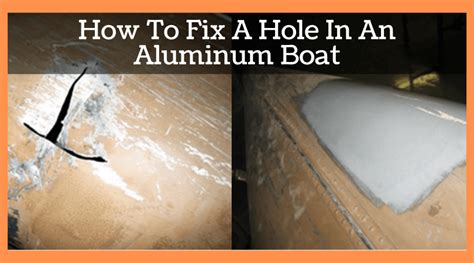Simple Steps to Repairing a Hole in Your Aluminum Boat
A hole in your aluminum boat can be a real headache, but with the right approach and materials, it's a repairable problem. This guide provides simple steps to effectively patch that hole and get you back on the water. Remember, safety is paramount; always wear appropriate safety gear when working on your boat.
Assessing the Damage: What Kind of Hole Are We Dealing With?
Before you start, it's crucial to assess the severity of the damage. A small pinhole requires a different approach than a larger gash. Consider these factors:
- Size of the hole: A tiny hole might be sealed with a simple sealant, while larger holes necessitate a more substantial patch.
- Location of the hole: Holes below the waterline are obviously more urgent and require immediate attention than those above.
- Shape of the hole: Irregular tears may require more preparation than clean, round holes.
Materials You'll Need for Aluminum Boat Repair
Gathering the correct materials beforehand streamlines the repair process. You'll likely need:
- Aluminum patch: Choose a patch slightly larger than the hole. The thickness should match or exceed that of your boat's hull.
- Marine-grade epoxy: This strong adhesive is designed to withstand water and UV exposure.
- Sandpaper (various grits): You'll need coarse grit for initial cleaning and finer grits for smoothing.
- Cleaning solvent (acetone or denatured alcohol): To thoroughly clean the repair area.
- Mixing sticks and cups: For properly mixing the epoxy.
- Safety glasses and gloves: Always prioritize your safety.
- Putty knife or scraper: To apply and smooth the epoxy.
- Clamp (optional): To hold the patch in place while the epoxy cures.
Step-by-Step Guide to Repairing the Hole
Now, let's get down to the actual repair process:
-
Clean the area: Thoroughly clean the area surrounding the hole using a cleaning solvent. Remove any loose paint, debris, or oxidation. Use sandpaper to roughen the surface slightly, promoting better adhesion.
-
Prepare the patch: If necessary, cut your aluminum patch to a size slightly larger than the hole. Sand the edges to create a smooth transition.
-
Apply the epoxy: Carefully mix the marine-grade epoxy according to the manufacturer's instructions. Apply a generous layer of epoxy to both the back of the patch and the surface of the hole.
-
Attach the patch: Firmly press the patch onto the hole, ensuring complete contact with the epoxy. If you're using a clamp, apply it gently to maintain even pressure. Allow the epoxy to cure completely according to the manufacturer's instructions (usually 24-48 hours).
-
Sand and finish: Once the epoxy is cured, use sandpaper to smooth out any excess epoxy and create a flush surface. You may need to use multiple grits, starting coarse and finishing fine.
-
Paint (optional): If desired, apply a coat of marine-grade paint to match your boat's existing finish, providing protection against corrosion.
How Long Does Aluminum Boat Repair Take?
The total repair time depends on the size and complexity of the hole, as well as the curing time of your epoxy. Simple repairs might take a few hours, while more extensive repairs can take a day or two, including curing time.
What Kind of Epoxy Should I Use for Aluminum Boat Repair?
Use a high-quality, two-part marine-grade epoxy designed for underwater use. These epoxies are formulated to resist water, UV degradation, and the harsh marine environment. Always follow the manufacturer's instructions carefully.
Can I Use JB Weld to Repair a Hole in My Aluminum Boat?
While JB Weld is a strong adhesive, it's not ideally suited for underwater repairs on aluminum boats in the long term. Marine-grade epoxy is specifically designed to withstand the constant exposure to water and saltwater corrosion, offering better durability and longevity.
How to Prevent Future Holes in Your Aluminum Boat
Prevention is always better than cure. To minimize the risk of future damage, consider these preventative measures:
- Careful docking and handling: Avoid bumping your boat against docks, rocks, or other objects.
- Regular inspections: Periodically inspect your boat for any signs of damage, no matter how small.
- Proper storage: Store your boat in a protected area when not in use.
By following these simple steps, you can successfully repair a hole in your aluminum boat and enjoy many more hours on the water. Remember to always prioritize safety and use appropriate safety gear.

